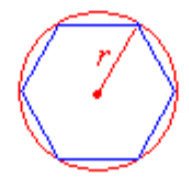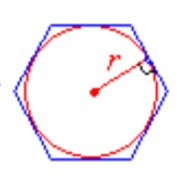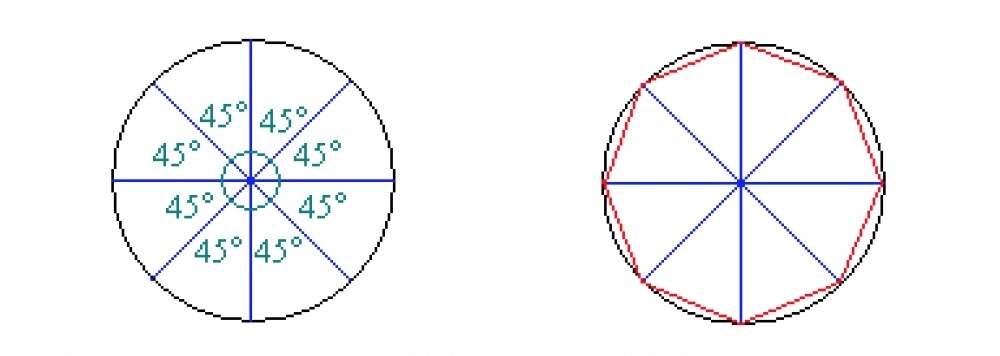2. Polygons
Polygons
A closed two-dimensional area that is bounded by a polygonal chain is called a polygon. The polygonal chain forms the perimeter of the polygon. If all the sides of a polygon are equal in length and all the angles of the polygon are equal, the polygon is a regular polygon. Calculating the area of a polygon often requires dividing the polygon into parts. Regular polygons can be divided into equilateral central triangles that are congruent. A polygon is named after its angles, vertices, or sides.
The sum of the angles of a polygon with [[$ n $]] angles is [[$ (n - 2) \cdot 180° $]].
The sum of a polygon's angle and its corresponding adjacent angle is always [[$ 180 ° $]]. The sum of all adjacent angles of a polygon is [[$ 360 ° $]].
The magnitude of the adjacent angles of a regular polygon that has [[$ n $]] angles is [[$ \beta = \displaystyle\frac {360°} {n} $]]
Regular polygons are similar to one another. For example, all equilateral triangles resemble each other, as do all squares.
The ratio of the areas of similar polygons is proportional to the square of their side length ratios.
Example 1

What is the area of a smaller square when the ratio of the side lengths of the two squares is [[$ 5 : 4 $]]?
Solution:
Denote the area of the smaller square with [[$ x $]]. All squares are similar with each other, so that the ratio of their areas is proportional to the square of the length ratios.
[[$ \begin{align*} \displaystyle\frac {49 \; \text {cm}^2} {x} &= \left ( {\displaystyle\frac {5} {4}} \right )^2 \\ \\ \displaystyle\frac {49 \; \text {cm}^2} {x} &= \displaystyle\frac {5^2} {4^2} \\ \\ \displaystyle\frac {49 \; \text {cm}^2} {x} &= \displaystyle\frac {25} {16} \;\;\;\;\;\;\;\;\;\;\;\;\;\; {\color{red} {\text {multiply both sides}}}\\ \\ x \cdot 25 &= 49 \; \text {cm}^2 \cdot 16 \;\;\;\;\; {\color{blue} { |\!| :25}}\\ \\ x &= \displaystyle\frac {49 \; \text {cm}^2 \cdot 16} {25} \\ \\ x &= 31 \; \text {cm}^2 \\ \end{align*} $]]Answer: The area of the smaller square is approximately [[$ 31 $]] cm[[$ ^2 $]].
A regular polygon has a center that is equidistant from all of its vertices and sides. A circle can be drawn around and inside a regular polygon using the polygon's center as the center of the triangle. Regular polygons can be drawn by utilizing circular sectors that have the same radius as the distance between the polygon's center and vertex.
 |
 |
| A circle which touches each vertice of a regular polygon. | A circle which touches each side of a regular polygon. |
Drawing regular polygons
- Determine the magnitude of one of the polygon's angles.
- Draw a circle and divide it into sectors that are equal to the adjacent angles of the polygon.
- Connect the rays inside the circle to form the polygon.
Example 2
Draw a regular octagon.
The magnitude of the adjacent angle [[$ \ beta $]] of a regular polygon can be calculated when the number of angles is known: [[$ \beta = \displaystyle\frac {360°} {8} = 45° $]].
The circle is divided into sectors that are equal to the adjacent angles of the polygon. After doing so, the rays are connected with chords. By doing so, a regular octagon is formed.
Exercises
Basic exercises
Applied exercises
Challenging exercises
2/02. Submission folder for answers
Sinulla ei ole tarvittavia oikeuksia lähettää mitään.